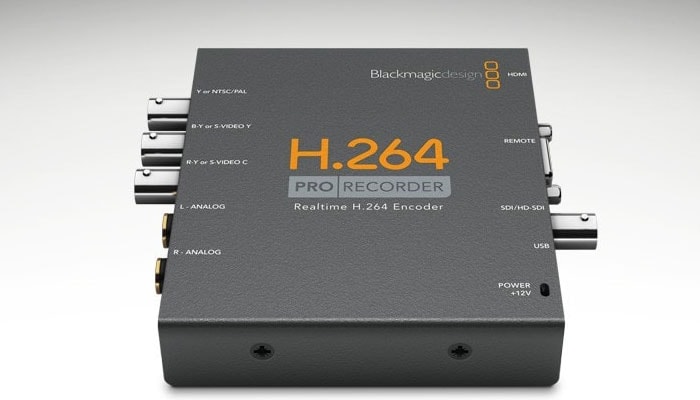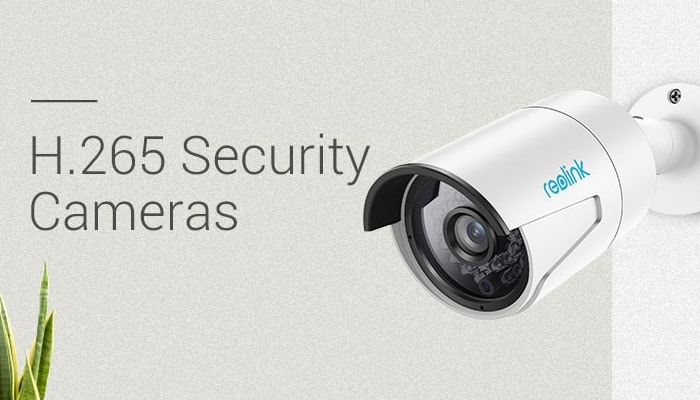Choosing the best video codec is essential for balancing file size and video quality when working with digital video content. In video editing software, H.264 and H.265 are widely used codecs that offer different benefits.
H.264 is a popular codec known for its good compression efficiency and widespread compatibility across devices and platforms, making it suitable for many uses. H.265, however, offers more advanced compression, reducing file sizes by up to 50% while maintaining the same video quality, which is ideal for 4K and 8K videos.
This article explores the key differences between H.264 vs. H.265 and the benefits and limitations of each. We'll guide you in which codec to choose for your projects based on these.
What Is a Video Codec?
A video codec is a tool that compresses video files for easier storage and transmission while maintaining video quality. Codecs are used in a variety of video devices, digital media applications, and video editing software.
Videos are made up of many individual images, and without compression, they have large storage and bandwidth requirements. A single high-definition image, for instance, can take up around 47 MB of storage requirements, so a video running at 30 frames per second (FPS) would consume several gigabytes of storage. This makes uncompressed video difficult to store or share.

High-Efficiency Video Coding
Video codecs assist by compressing video data using sophisticated algorithms that keep video quality as high as possible. Essentially, they "squeeze" large video files into smaller sizes (i.e., video compression), allowing more efficient video storage and transmission. The codec also decompresses the file when a video is played back, making it viewable.
There are several types of codecs in use, each with its own algorithm and compression efficiency, but the most popular are H.265 and H.264. These are widely used for streaming services like Netflix and YouTube and incorporate high-efficiency video coding for superior video compression.
What Is H.264?
H.264, also known as Advanced Video Coding (AVC), is a widely used video codec introduced in 2003. Jointly developed by the Video Coding Experts Group (VCEG) and the Moving Picture Experts Group (MPEG), it was designed to achieve high video compression efficiency while maintaining image quality. It is popular with streaming services as it provides high-quality video with a low bit rate.
Advanced Video Coding
H.264 achieves efficient results using advanced entropy coding and compression techniques, including intra- and inter-frame prediction, context-adaptive binary arithmetic coding (CABAC), macroblock representation (each with 16 x 16 pixels), and motion compensation by predicting motion between frames to reduce data redundancy.

Key features of H.264:
- High compression efficiency: H.264 significantly reduces file size compared to previous standards, like MPEG-2.
- Flexible macroblock partitioning: Frames are divided into smaller blocks, improving motion estimation and overall compression.
- Broad compatibility: H.264 is supported by a wide range of devices and platforms, from smartphones to smart TVs.
Advantages:
- Lower bandwidth requirements: H.264's efficient compression requires less data than previous standards, making it ideal for streaming.
- High video quality: Maintains good video quality, even at lower bit rates.
- Wide device support: Compatible with several hardware and software platforms, ensuring smooth playback across various devices.
Disadvantages:
- Increased processing requirements: H.264's advanced compression capabilities require more processing power than previous standards.
- Not the latest standard: Newer codecs like H.265 (see below) offer better compression efficiency, which makes H.264 less suitable for some situations.
What Is H.265?
H.265 is also known as High Efficiency Video Coding (HEVC) and was introduced in 2013 as a successor to H.264. It was developed by the Joint Collaborative Team on Video Coding (JCT-VC) and was formulated to provide improved compression efficiency over H.264 with the same quality.

Superior Video Compression
H.265 achieves more efficient compression than H.264 by leveraging several advancements in video compression technology, including:
- Image processing using blocks called "coding tree units" (CTUs) with adaptable block partitions.
- Advanced motion-vector prediction.
- Context-adaptive entropy coding.
- Higher bit depths (up to 14 bits).
H.265's superior efficiency makes it useful for high-resolution formats like 4K and 8K video, providing up to 50% more compression than H.264 while maintaining the same video quality.
Key features of H.265:
- Improved compression efficiency: H.265's compression efficiency is up to 50% more than H.264.
- Flexible block partitioning: CTUs range from 64x64 to 4x4 pixels, allowing for more efficient compression.
- Supports higher resolution: Capable of handling 4K and 8K video content.
Advantages:
- Reduces storage and bandwidth requirements: Uses half the bandwidth or storage requirements of H.264.
- Better video quality: Maintains higher quality video with reduced data usage.
Disadvantages:
- Requires more processing power: H.265's complex algorithms demand more computational resources than H.264, resulting in slower processing on hardware without adequate resources.
- Compatibility issues: Not supported as widely as H.264, causing problems with playback on some older hardware systems.
What's the Difference? H.264 vs. H.265
H.264 and H.265 use advanced encoding to reduce video file size while maintaining high-quality videos. H.264 is used by more platforms and mobile devices than H.265 and is widely used for live streaming.
While both codecs do a similar job, they differ in their efficiency, file size, computational requirements, and compatibilities. Deciding between H.264 and H.265 depends on your specific use cases and additional considerations like the type of device you're using, the required bandwidth, and the video quality you require.

Video Quality
Both H.264 and H.265 maintain a high standard of visual quality in compressed files. The main difference lies in the efficiency of their video encoding, with H.265 producing essentially the same quality video as H.264 at around half the bitrate. This means that H.265 video files are around half the size of H.264 files.
For example, a video encoded with H.264 might require a bitrate of 5 Mbps to maintain a high quality, whereas the same video encoded with H.265 would only need 2.5 Mbps. This reduced bitrate translates to less demand on bandwidth, which is crucial for streaming HD or ultra-HD content.
Compression Efficiency and Bitrate
Compression efficiency is particularly important when dealing with high-resolution formats like 4K and 8K, where the amount of data in each frame is significantly higher than in standard or HD videos. H.265's ability to handle larger file sizes with greater precision underpins its ability to stream high-quality video content without excessive bandwidth or storage.
H.265 achieves this through several key advancements in video encoding, the most notable of which is the use of CTUs rather than the macroblocks used in H.264. CTUs allow for more flexible block sizes, ranging from 4x4 to 64x64, allowing more efficient coding of large static areas and smaller, detailed sections of video.
H.265 also incorporates more advanced motion compensation techniques than H.264, allowing more accurate prediction of movement between frames and reducing the data required for video sequences. This means smoother video playback and higher quality at lower bitrates with H.265 vs. H.264, especially for fast-moving or highly detailed content.

Processing Power and Compatibility
Despite its superior compression efficiency, H.265 does come with some trade-offs. The most notable of these is increased processing requirements for encoding and decoding videos due to H.265's more advanced encoding techniques. Devices without hardware support for H.265 may struggle to play back H.265 encoded videos, particularly at higher resolutions like 4K or 8K.
H.264, on the other hand, has been around for much longer and is supported by virtually every device capable of playing video, from smartphones to smart TVs. Its lower processing requirements make it more accessible for devices with limited processing power, such as older smartphones, tablets, or embedded systems.

The widespread adoption of H.264 also means that video streaming services, social media platforms, and online video players are optimized for H.264 playback.

H.265, meanwhile, has experienced slower adoption due to its higher computational demands and need for more powerful hardware.
Key differences: Summary
The table below summarizes the key differences between H.264 and H.265:
Features H.264 H.265 Compression effciency Achieves good compression Up to 50% more efficient than H.264 Video quality High quality but higher bitrate Same quality at half bitrate Bitrate Higher to maintain quality 50% lower for same quality video Resolution Supports up to 4K Supports up to 8K File Size Larger file sizes Smaller file sizes Processing power Lower computational requirements Higher computational requirements Device compatibility Supported on most devices Limited compatibility with older devices Motion estimation Less accurate prediction More precise motion compensation Block partitioning Uses fixed 16x16 macroblocks Uses flexible CTUs (16x16 to 4x4) Latency Lower latency, faster encoding Higher latency due to complex encoding Bandwidth Requires more bandwidth Requires less bandwidth Use cases Standard for streaming and broadcasting Ideal for high-resolution video storage/streaming Adoption Widely adopted as the industry standard Growing adoption albeit with compatibility issues
How to Choose Between H.264 and H.265
So, how do you decide between H.264 and H.265?
You should consider your specific needs and the context in which your video will be used:
- If you need to stream or store high-resolution video content, such as 4K or 8K, H.265 is generally better due to its higher compression efficiency and lower bandwidth requirements, particularly over constrained networks.
- If compatibility and ease of use are your priorities, H.264 may be the safer option given its widespread device support and more consistent viewing experience with older devices and over platforms that do not yet fully support H.265.
- If power consumption concerns you, H.264's lower computational demands may be more suitable, given H.265's tendency to drain battery life more quickly and add more strain to lower-end hardware or devices lacking dedicated hardware acceleration.
Final Words
Both H.264 and H.265 provide effective video compression, but H.265's more advanced algorithms provide greater efficiency, delivering the same video quality at half the bitrate. This comes with increased complexity, requiring more processing power and hardware support.
H.264 remains widely compatible and easier to implement, while H.265 is ideal for modern, high-resolution formats like 4K and 8K.
Ultimately, your choice depends on your device capabilities, streaming needs, and whether you prioritize compression efficiency or compatibility. Whichever you choose, both codecs offer excellent video compression results for a range of applications.
FAQ
Is H.265 better than H.264?
H.265 is generally better than H.264 due to its primary benefit of offering up to 50% more compression efficiency, which helps save disk space while maintaining the same video quality. This makes it ideal for streaming high-resolution content like 4K and 8K. However, H.264 has wide compatibility with more devices, especially older ones, while H.265 is best suited for modern devices with the processing power to handle its more advanced compression techniques.
H.264 or H.265: Which One to Use for YouTube?
H.264 is the preferred codec for YouTube because it offers wide compatibility with the platform and most devices. While H.265 provides better compression and lower bitrates, YouTube primarily supports H.264 for uploads, ensuring smoother processing and playback across different browsers and devices.











